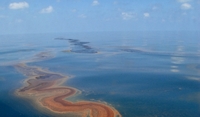Oil Spills - Large and Small - Create Continuing Disaster
 BP Oil Disaster in Gulf of Mexico - EPA photo |
By Edwin Black
Special Report from TheCuttingEdgeNews.com
 |
This continuing coverage of America’s oil crisis arises from the The Plan: How to Save America When the Oil Stops—or the Day Before (Dialog Press).
Environmental damage caused by the petroleum industry and its consumers is earth-shattering, literally. The world focus is now on BP’s massive, out-of-control underwater gusher in the Gulf of Mexico. Estimates of that oil pollution telescope across the numbers. Many sources estimate as much as 5,000 barrels per day are escaping into the Gulf. Other experts say the true number is closer to 1.1 million gallons—approximately 26,500 barrels— per day. A barrel of crude equals about 42 gallons. It is all evolving guesswork based on a cascade of satellite images and thickness estimates derived from visual descriptions of the slick. At press time, at least 4 million gallons—or as many as 21 million gallons—have thus far spilled, and the spill clock is rapidly racing forward.
Thus far, the media is comparing this current disaster to the Exxon Valdez event. The Exxon Valdez spilled 10.8 million gallons into Alaska’s Prince William Sound in March 1989, devastating the shore along with the area’s sea life, birds, and furry animals. Oil spills such as that of the Exxon Valdez inflict severe local ecological disasters where they occur. The Exxon Valdez incident is famous, but is hardly the largest spill in recent years.
Saddam Hussein’s intentional destruction of Kuwaiti oil wells caused 24 million to 60 million gallons of crude to gush into the Persian Gulf. But the largest spill on record is from Pemex’s Ixtoc I. From June 3, 1979, until it was capped forty-two weeks later, Ixtoc I dumped an estimated 151.2 million gallons of crude into the Gulf of Mexico, most of which floated toward the Texas coastline.
The list of major oil spills is long and spans the globe. In fact, during the past twenty years, the world has witnessed 30 oil spills larger than the Exxon Valdez. During the 1990s, 346 spills occurred in excess of 2,000 gallons, or an average of about 10.6 million gallons annually—that is, an additional Exxon Valdez every year.
What a spill can do as a huge incident, all of us do incrementally. Daily gasoline runoff from streets, driveways, and other domestic leaks pour nearly 11 million gallons—equal once again to an Exxon Valdez spill—into American waterways every eight months, according to the National Academy of Sciences. The damage from all these spills—from very slight to very Exxon Valdez—lasts years longer than scientists originally thought. The food chain and the world’s waters are being progressively poisoned, as are the coastlines; the damage is outstripping nature’s ability to repair itself.
What oil does to the water, it also does to the land. Coastlines suffer from oil spills with the familiar scenes of tar-coated shores, blackened and crippled birds, and other hapless creatures unable to get clean. But the environmental destruction from routine exploration, drilling, extraction, refining, and distribution can exceed the damage of a major oil spill, according to a University of California study. Adverse ecological effects include deforestation of large tracts of wooded regions, chemical contamination of land, and concomitant harm to whole animal populations.
What’s more, America’s oil and gas industry creates more solid and liquid waste than all other municipal, agricultural, mining, and industrial sources combined. In 1995, the American oil industry by itself spawned 146 million barrels of drilling waste and 22 million barrels of so-called associated wastes. Associated wastes include the “produced water” used in drilling operations. This water, often discharged into the American water system, is at least four times saltier than ocean water and commonly contains megaconcentrations of toxins such as benzene, xylene, and ethylbenzene. Produced water can in some instances be 100 times more radioactive than nuclear power plant effluent.
So long as society is addicted to oil, the true price will only become known when it hurts most. Besides that price at the pump, we must include not only defense spending and diplomatic costs, but also environmental clean-ups that make the headlines once every year or two, but in fact are daily footnotes of our petroliferous existence.
Edwin Black is the New York Times best selling investigative author of IBM and the Holocaust, Internal Combustion, and The Plan: How to Save America When the Oil Stops—or the Day Before. For more information about Edwin Black visit www.edwinblack.com


